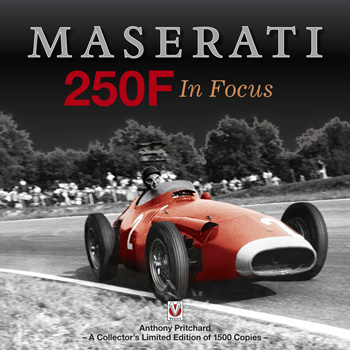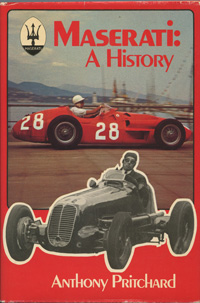 By Pete Vack
By Pete Vack
Maserati 250F In Focus
By Anthony Pritchard
10 x10, 224 pages, 192 color and B&W photos
£60 UK, $95 USD, $105 CAN
Veloce Publishing Limited, UK, 2014
ISBN 978-1-845845-63-6
Order from www.veloce.co.uk
Review by Pete Vack
Anthony Pritchard’s name should ring a bell with most Maserati enthusiasts for he authored the first comprehensive history of Maserati, published in 1976. Comparable to the Merritt/Fitzgerald Ferrari in 1968 and the 1964 Hull/Slater Alfa Romeo, Maserati: A History, was a watershed work and most remarkably, still a valuable resource over 38 years later.
Along with Denis Jenkinson’s early work on the history of the 250F chassis numbers, first seen in The Maserati 250F: A Classic Grand Prix Car in 1975, Pritchard was one of the first to list all the 250F chassis numbers, something Ferrari historians were also attempting to do with the Maranello marque. Both Jenkinson and Pritchard, however, were often led astray by the factory’s use and re-use of chassis numbers. As time went by and more research revealed new facts about the cars, the old histories needed updating. Among the most recent to try to correct dated S/N information were David McKinney and Barry Hobkirk (McKinney published with The Maserati 250F in 2003).
 Unfortunately Pritchard passed away shortly before the publication of his last book, the Maserati 250F In Focus. Fortunately, the book reflects those updated facts learned over the years, and much more as well. Pritchard begins with old history, and relates the growth of the Maserati firm and its racing activities from 1926 to the A6G series. Very little new here of course but one can assume Pritchard has made good use of his superlative sources and we can be sure the material is if not fresh is then accurate. This history is followed by the design and development of the 250F from the A6GCM to the final lightweight 1957 250Fs.
Unfortunately Pritchard passed away shortly before the publication of his last book, the Maserati 250F In Focus. Fortunately, the book reflects those updated facts learned over the years, and much more as well. Pritchard begins with old history, and relates the growth of the Maserati firm and its racing activities from 1926 to the A6G series. Very little new here of course but one can assume Pritchard has made good use of his superlative sources and we can be sure the material is if not fresh is then accurate. This history is followed by the design and development of the 250F from the A6GCM to the final lightweight 1957 250Fs.
The bulk of the Pritchard book is devoted to the major races in which the 250F participated from 1954 to 1960, but also mentioning the odd events up to 1963, all with the S/N listed in the results. However, if one would like to determine in what races did S/N 2529 participate, for example; that might be a bit time-consuming. There is no chassis number index, and one has to sort through the year results, which do list the cars, drivers, placings and S/Ns of the major events. But can you find all the information under one Serial Number? No.

1952, at the Italian Grand Prix, the A6GCM twin plug engine was ready for Froilan Gonzales, Felice Bonetto and Franco Rol. Still under the faux 2 liter formula, these cars were the precursors to the 250F. Gonzalez finished second to Ascari’s Ferrari. This photo is from Pritchard’s collection.
A fair criticism might be leveled at the S/N history section, which one might think would be the ultimate last word on the 250F. However, Pritchard’s intent was to ensure that the race and ownership history only extend to the “end of its mainstream racing days with just a brief mention of subsequent ownership where they are of sufficient interest.” On one hand, we care little what wealthy investor or dealership owned what S/N for the past 45 years; on the other, a complete ownership trail helps to keep the history intact and aids in tracking the actual car. And this is a problem today for as Pritchard relates, Collector Matteo Panini “…has suggested that there are more than twice as many claimed surviving 250F as were originally built.”

While photos of the famous Moss 250F are common, good shots of the Owen’s S/N 2509 are rare. Here is Peter Collins giving it a go at the 1955 British Grand Prix. A piston rod failed and he had to retire. The Owen organization never did match the superb preparation and maintenance of the Moss Maserati. Another photo from Pritchard’s collection.
Part of this was due to the well-intentioned efforts of the late and brilliant Cameron Millar, who created a series of 250F facsimiles, which although were properly assigned CM numbers 1-10 allowed others to muddy the waters which were once somewhat clear.
May I digress?
Pritchard’s book makes use of material found in a number of other books including Alf Francis, Racing Mechanic, published in 1958, Tony Rudd’s It Was Fun!—My Fifty Years of High Performance, and Roy Salvadori, Racing Driver by Pritchard and Roy Salvadori. Francis was the master mechanic in charge of the Stirling Moss 250F 2508; Rudd managed the Owen (BRM) Organization’s 250F S/N 2509, and Roy Salvadori drove 2507 for Gilby Engineering. These three books tell us a goodly amount about the realities of owning, racing and maintaining a 250F Maserati in the era. Tony Rudd minces no words in describing BRM’s experiences and Salvadori lets us know on no uncertain terms what he thought about the Gilby Maserati. Axes to grind perhaps, but making for sharper commentary and a far deeper understanding of the era.

Another British-owned Maserati was S/N 2507, here enroute to practice at Silverstone in 1954. This photo was taken by Tom March, whose excellent B&Ws are see throughout the book. Salvadori too, was often plagued by mechanical failures
Pritchard chronicles development details in his chapter on same, discussing the use of fuel injection, discs brakes, the placement of the oil tanks and related oil problems; a full bore set of race results and blow by blow action and revived our interest in the 250F. For a hands-on view, we were prompted to go back to the library. Of the books mentioned, in particular, Alf Francis gives us an insider’s view written at the time as he made copious notes during his 1954 tenure with Moss. He describes not only the way in which the 250F was designed and assembled at the factory, (it took two talented mechanics a full 12 hours to change the reduction gears; there were no traditional gaskets of any kind on a 250F engine but metal to metal surfaces; the space frame chassis wasn’t). In addition, the various teething problems that affected Moss’s performances, which often ended in retirements during the 1954 season. The list is fascinating; a nut falls off of a quick-release oil cap and falls into the tank and breaks the oil pump; oil lines along the side of the car are too rigid and become prone to breakage; the oil tank as originally placed up front gets hot and froths the oil, leaving little oil pressure; a locknut holding a transmission gear unravels, allowing the drive gear to simply fall off its shaft; a motor mount breaks, allowing all the oil to escape and fries the engine; piston rods are reused after peening and shatter like glass under hard use.

Bertocchi shows Fangio a plug from Harry Schell’s 250F at Aintree in 1957. Fangio, driving 2529 again, was not on form and retired with engine failure. Courtesy FotoVantage
Francis was sent to Modena to help assemble the new Maserati, in the process learning every nut and bolt and ensuring that it used the best parts available. While befriending Fantuzzi, Alf immediately ran afoul of Guerino Bertocchi; Moss wanted the brake pedal to be placed in the center, Bertocchi refused. It was the first of many arguments Francis had with Bertocchi, who was right about a lot of other things, like tire choice. Francis was absolutely amazed at the rest of the factory workers and mechanics, who would freely work 24 x 7 in order to help Moss get his car right.
A the end of the year, Moss went to Mercedes, and this had a tremendously negative effect on the Maserati factory and mechanics; they knew they had a great car, but no driver worthy of Moss or Fangio. Neubauer of course knew that as well. Francis also thought – and perhaps rightly so – that if Moss had continued on with Maserati for 1955 as planned (and Francis would have worked for Maserati in that case) the Germans would have had much more serious competition. It would have been Fangio-Moss 1-2, but Moss would have been driving a Maserati, not Mercedes.
Back to Pritchard
My digression was to point out that the more one learns about the life and times of the 250F, the more one can appreciate Pritchard’s technicalities, statistics and race reports. And, in his own way, despite a plethora of facts, Pritchard too, let his personality out of the bag at times. Upfront, Veloce Publishing Editor Rod Grainger noted that he ‘will miss Anthony’s infectious enthusiasm…and his strident opinions!”, and it was not too many pages therein that we were treated to a strident example of Pritchard’s opinion, to wit; “…Argentine Onofre Marimón, who was not, and never could be, a great driver…” Poor Marimón died before proving this one way or another. Perhaps Pritchard really meant “was not, and never would be…” But then again, perhaps not.

This is American Carroll Shelby in one of his few Grand Prix appearances. By 1958 the 250F was a bit long in the tooth but on a good day still competitive. Shelby finished 9th overall, driving 2522. Courtesy FotoVantage
Insofar as layout and art, the hardbound book is well done; captions are often not set off well enough from the text. The 10 x 10 inch paper allows for large and well-placed images, many from Pritchard’s own archives. Many have been previously published, but all are nicely reproduced and relevant to the accompanying text. There is a decent bibliography and index along with appendices.
Pritchard’s book adds to the body of knowledge about the 250F, but the definitive work remains to be written. Nevertheless, Maserati 250F In Focus, for only $95 USD is a worthy addition to any Maserati book collection.